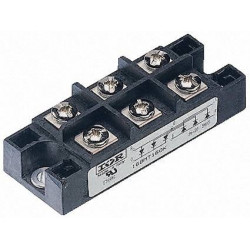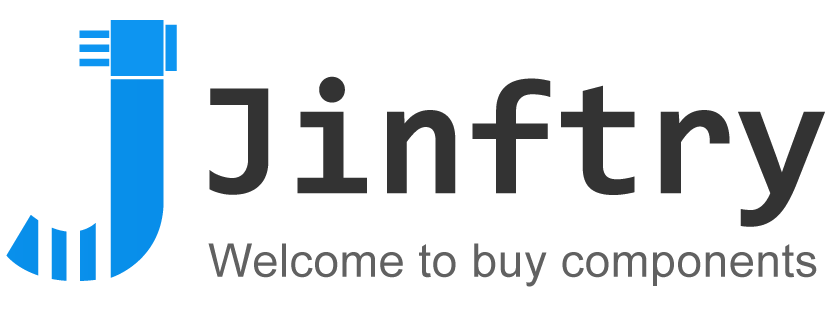What is a bridge rectifier?

What is a bridge rectifier?
The bridge rectifier is composed of four rectifier silicon chips connected in a bridge manner and encapsulated with an insulating plastic material. The high-power bridge rectifier is encapsulated by a zinc metal shell outside the insulating layer to enhance heat dissipation. There are many types of bridge rectifiers: flat, round, square, bench-shaped (divided into direct plug and patch), etc., and divided into GPP and O/J structures. The maximum rectified current ranges from 0.5A to 100A, and the maximum reverse peak voltage ranges from 50V to 1600V. A half-bridge seals together two halves of a diode bridge rectifier. Two half-bridges can be used to form a bridge rectifier circuit, and one half-bridge can also form a full-wave rectifier circuit with a center tap of a transformer. When choosing a rectifier bridge, consider the rectifier circuit and operating voltage. The rectifier bridge stack is generally used in full-wave rectification circuits, and it is divided into full bridge and half bridge.
The full bridge is composed of four rectifier diodes connected in the form of a bridge full-wave rectifier circuit and packaged into one. The picture is its appearance. The forward current of the full bridge is available in various specifications such as 0.5A, 1A, 1.5A, 2A, 2.5A, 3A, 5A, 10A, 20A, 35A, 50A, etc., and the withstand voltage value (maximum reverse voltage) is 25V, 50V, 100V, 200V, 300V, 400V, 500V, 600V, 800V, 1000V and other specifications.

The role of bridge rectifier
The bridge rectifier is used in the alternator power supply system. Its function is to convert the alternating current generated by the alternator into direct current to supply power to electrical equipment and charge the battery. The second function is to limit the reverse flow of battery current back to the generator to protect the battery. The generator is not burned out by reverse current. Silicon diodes have the characteristic of unidirectional conduction, that is, when a certain voltage is applied to both ends of the silicon diode (the positive electrode of the power supply is connected to the positive electrode of the diode, and the negative electrode of the power supply is connected to the negative electrode of the diode), the diode will conduct and current will flow. On the contrary, the diode will not conduct electricity. On, no current flows. This way, current can only pass in one direction. People use this characteristic of diodes to make rectifiers. When AC voltage is applied to the rectifier, only the positive half cycle of the AC power is allowed to pass, but the negative half cycle is not allowed to pass, so pulsating DC power is output at the negative end of the rectifier.
How bridge rectifier works
As shown in Figures a, b, and c below, it is a bridge rectifier circuit composed of four diodes. Three commonly used drawing methods are drawn in the picture. It consists of four diodes VD1~VD4. Its structural characteristics are: the negative poles of VD1 and VD2 are connected to the positive terminal of the load; the positive poles of VD3 and VD4 are connected to the negative terminal of the load; the positive pole of VD1 is connected to the negative pole of VD4, and the positive pole of V2 is connected to the negative pole of V3. Connected to both ends of the secondary side of transformer T respectively. RL is the load.
Working principle of bridge rectifier_function of bridge rectifier_bridge rectifier wiring diagram, as shown in figure a below, in the positive half cycle, the potential of point a is higher than the potential of point b, diodes VD1 and VD3 are conducting, and VD2 and VD4 are in reverse Cut off towards bias two. The current flows from terminal a on the secondary side of the transformer through VD1 to RL and then through VD3 back to terminal b, as shown in Figure b below. At this time, the load RL gets a half-wave voltage uo and current io that are the same as the positive half-wave of u2, as shown in Figure c below.
When u2 is a negative half cycle, the potential of point a is lower than the potential of point b, diodes VD2 and VD4 are on and VD1 and VD3 are off. The current passes from terminal b through VD2 to RL, and then returns from RL to terminal a through VD4, as shown in Figure d above. shown. The load gets another half-wave voltage uo that is the same as the positive half-wave of u2 but has a phase difference of 180° and the circuit io, as shown in Figure c. In this way, within one cycle of the sinusoidal voltage, two positive half-cycle voltages and currents are obtained on the load RL, so it is called full-wave rectification. The voltage waveform obtained after rectification is called a single-phase pulsating voltage waveform, and its average value Uo is used as the equivalent DC voltage.
Main types of bridge rectifiers
Single-phase bridge rectifier: suitable for converting single-phase alternating current into direct current, generally composed of four diodes.
Three-phase bridge rectifier: suitable for converting three-phase alternating current into direct current, generally composed of six diodes.
Half-bridge rectifier: Two diodes are packaged together, which is equivalent to half of a single-phase bridge rectifier, and is suitable for low-power circuits.
Full-bridge rectifier: Four diodes are connected and packaged into one in the form of a bridge full-wave rectifier circuit, which is suitable for high-power circuits.
edit author:

Jinftry(Hong Kong registered company name: JING FU CAI (HONGKONG) INTERNATIONAL CO., LIMITED) is an electronic parts distributor selling latest electronic components including integrated circuits, IC electronics, IC integrated circuits, IGBT, IGBT modules, button battery LR44,discrete te semiconductors, circuit protection, capacitors, resistors, potentiometers, transformers, isolators, crystals , oscillators, resonators, power managers, connectors, switches, relays, sensors, optoelectronic devices, diodes, and various batteries. Welcome to purchase electronic components from brand manufacturers. To view the solutions, you can log in to https://www.jinftry.com/ for inquiries







